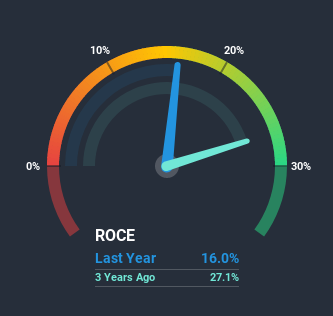- Hong Kong
- /
- Construction
- /
- SEHK:589
Our Take On The Returns On Capital At Jianzhong Construction Development (HKG:589)

There are a few key trends to look for if we want to identify the next multi-bagger. Typically, we'll want to notice a trend of growing return on capital employed (ROCE) and alongside that, an expanding base of capital employed. Basically this means that a company has profitable initiatives that it can continue to reinvest in, which is a trait of a compounding machine. Although, when we looked at Jianzhong Construction Development (HKG:589), it didn't seem to tick all of these boxes.
Return On Capital Employed (ROCE): What is it?
Just to clarify if you're unsure, ROCE is a metric for evaluating how much pre-tax income (in percentage terms) a company earns on the capital invested in its business. Analysts use this formula to calculate it for Jianzhong Construction Development:
Return on Capital Employed = Earnings Before Interest and Tax (EBIT) ÷ (Total Assets - Current Liabilities)
0.16 = CN¥185m ÷ (CN¥1.9b - CN¥756m) (Based on the trailing twelve months to June 2020).
Thus, Jianzhong Construction Development has an ROCE of 16%. In absolute terms, that's a satisfactory return, but compared to the Construction industry average of 10% it's much better.
Check out our latest analysis for Jianzhong Construction Development

While the past is not representative of the future, it can be helpful to know how a company has performed historically, which is why we have this chart above. If you're interested in investigating Jianzhong Construction Development's past further, check out this free graph of past earnings, revenue and cash flow.
So How Is Jianzhong Construction Development's ROCE Trending?
When we looked at the ROCE trend at Jianzhong Construction Development, we didn't gain much confidence. Over the last three years, returns on capital have decreased to 16% from 27% three years ago. Meanwhile, the business is utilizing more capital but this hasn't moved the needle much in terms of sales in the past 12 months, so this could reflect longer term investments. It's worth keeping an eye on the company's earnings from here on to see if these investments do end up contributing to the bottom line.
On a related note, Jianzhong Construction Development has decreased its current liabilities to 39% of total assets. That could partly explain why the ROCE has dropped. Effectively this means their suppliers or short-term creditors are funding less of the business, which reduces some elements of risk. Since the business is basically funding more of its operations with it's own money, you could argue this has made the business less efficient at generating ROCE.
In Conclusion...
Bringing it all together, while we're somewhat encouraged by Jianzhong Construction Development's reinvestment in its own business, we're aware that returns are shrinking. Since the stock has declined 20% over the last year, investors may not be too optimistic on this trend improving either. All in all, the inherent trends aren't typical of multi-baggers, so if that's what you're after, we think you might have more luck elsewhere.
On a final note, we found 3 warning signs for Jianzhong Construction Development (1 makes us a bit uncomfortable) you should be aware of.
While Jianzhong Construction Development may not currently earn the highest returns, we've compiled a list of companies that currently earn more than 25% return on equity. Check out this free list here.
If you decide to trade Jianzhong Construction Development, use the lowest-cost* platform that is rated #1 Overall by Barron’s, Interactive Brokers. Trade stocks, options, futures, forex, bonds and funds on 135 markets, all from a single integrated account. Promoted
New: Manage All Your Stock Portfolios in One Place
We've created the ultimate portfolio companion for stock investors, and it's free.
• Connect an unlimited number of Portfolios and see your total in one currency
• Be alerted to new Warning Signs or Risks via email or mobile
• Track the Fair Value of your stocks
This article by Simply Wall St is general in nature. It does not constitute a recommendation to buy or sell any stock, and does not take account of your objectives, or your financial situation. We aim to bring you long-term focused analysis driven by fundamental data. Note that our analysis may not factor in the latest price-sensitive company announcements or qualitative material. Simply Wall St has no position in any stocks mentioned.
*Interactive Brokers Rated Lowest Cost Broker by StockBrokers.com Annual Online Review 2020
Have feedback on this article? Concerned about the content? Get in touch with us directly. Alternatively, email editorial-team (at) simplywallst.com.
About SEHK:589
Jianzhong Construction Development
Provides construction services in the People’s Republic of China.
Adequate balance sheet and overvalued.
Market Insights
Community Narratives



